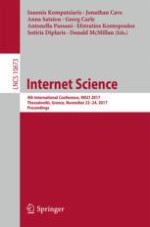2017 | Buch
Internet Science
4th International Conference, INSCI 2017, Thessaloniki, Greece, November 22-24, 2017, Proceedings
herausgegeben von: Ioannis Kompatsiaris, Jonathan Cave, Anna Satsiou, Georg Carle, Dr. Antonella Passani, Efstratios Kontopoulos, Sotiris Diplaris, Donald McMillan
Verlag: Springer International Publishing
Buchreihe : Lecture Notes in Computer Science
